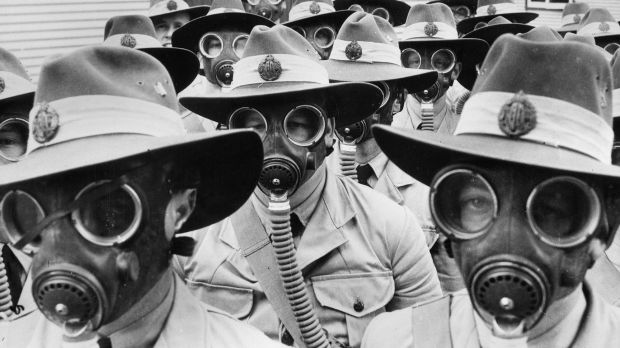
Toxic Exposures
Mustard Gas and the Health Consequences of
World War II in the United States
Susan L. Smith
(Rutgers University Press)

As we report in this issue of our magazine, quoting from the terrific military history, Where Have All The Soldiers Gone?Poison gas was used more extensively after the end of WWI than during the conflict. Examples: The British in Afghanistan (1919) and in Iraq (1920), the Italians in Libya (1923 - 1924) and in Ethiopia (1935) and the Spanish in Morocco (1921 - 1927). In 1920, Winston Churchill said, I am strongly in favor of using poison gas against uncivilized tribes."
It's odd indeed that the military of Japan, Russia, Germany and especially England - - - despite Churchill's enthusiastic use of gas against people as uncivilized as you and me - - - decided against it.
But that is only a partial truth, for in other areas outside the battlefields, gas was used extensively on humans. The Germans used Zyklob B in their pogroms of Jews, the disabled, gypsies, and homosexuals, while American cooperated with Australia, Canada, and England to test it extensively in domestic settings.
Indeed, as Smith explains, as many as 65,000 men, women, and people of color were exposed to sulfur mustard, lewisite, phosogene in controlled experiments in Colorado, Arkansas, Alabama, and Maryland. The subjects were "volunteers" according to official records, but you know about volunteerism in the military: he stands in front of you and ask for volunteers for a program that will "save American lives" and he looks at you and you know you are doomed.
Some of the experiments here are enough to curl your short hairs, if not make you cough. And, as Smith proves, "The declaration that no men were harmed as research subjects is not supported by the historical evidence," notably official releases of the government's Chemical Warfare Service. A WAAC - - - women's army corps - - - reported that while entering a chamber filled with mustard gas, "I was required to remove my gas mask and repeat my name, rank & serial number . . . My health problems now consist of chronic bronchitis, emphysema & sinus problems."
In 1943, there was, in Suffield (Canada), a "Vapour Danger from Gross Mustard Contamination" test, where men "became very sick and were hospitalized with a high fever, nausea, and vomiting."
There were also psychological consequences from the intense fear that these young men experienced, especially when they begged to be let out of the gas chambers but were refused.
Soldiers recalled the embarrassment of being treated by nurses for their "grotesque blisters that sometimes developed, especially in the armpits and on the genitals." One nurse, who eventually married one of the soldiers, "remembered her husband's suffering and the healing took a very long time because, "as soon as one blister broke and ran, underneath was another blister."
Smith, in her conclusion, reports that veterans were warned that if "they ever told anyone they would be prosecuted under the Espionage Act.
"Secrecy was one of the defining issues in the American mustard gas story," she writes; "secrecy in wartime is nothing new, but as this book demonstrates, too much secrecy exacerbates human suffering."
--- Pamela Wylie